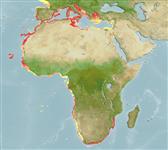Classificação / Names
Common names from other countries
Referência principal
Tamanho / Peso / Idade
Max length : 55.0 cm TL macho/indeterminado; (Ref. 3397); common length : 30.0 cm TL macho/indeterminado; (Ref. 3688); Idade máx. registada: 12 anos (Ref. 13716)
Length at first maturity
Lm 18.8, range 20 - ? cm
Ambiente
; marinhas; estuarina demersal; intervalo de profundidade 0 - 150 m (Ref. 3688), usually 10 - 20 m (Ref. 37413)
Clima / Intervalo
Subtropical, preferred 23°C (Ref. 107945); 48°N - 35°S, 25°W - 36°E
Distribuição
Eastern Atlantic: Bay of Biscay, Strait of Gibraltar and Mediterranean; southward to Cape of Good Hope, South Africa; around the Canary and Cape Verde Islands (Ref. 3688); and Madeira Is (Ref. 74541). Western Indian Ocean: southern Mozambique (Ref. 3688). Not found in tropical east Africa (Ref. 3198), Red Sea (Ref. 84159) and Black Sea (Ref. 4781, 112870).
Países | Áreas FAO | Ecossistemas | Ocorrências | Introduções
Descrição suscinta
Espinhos dorsais (total): 11; Raios dorsais (total): 12-13; Espinhos anais 3; Raios anais : 10 - 11
Status na Lista Vermelha da IUCN (Ref. 115185)
Perigo para os humanos
Harmless
Uso pelos humanos
Pescarias: pouco comercial; peixe esportivo: sim
Mais informação
ReferênciasAquaculturaPerfil para aquaculturaEstirpesGenéticaFrequência alélicaHereditariedadeDoençasProcessamentoMass conversion
ColaboradoresFotosStamps, CoinsSonsCiguateraVelocidadeTipo de nataçãoÁrea branquialOtólitosCérebrosVisão
Ferramentas
Relatórios especiais
Baixar XML
Fontes da internet
Estimates of some properties based on models
Phylogenetic diversity index
PD50 = 0.5625 many relatives (e.g. carps) 0.5 - 2.0 few relatives (e.g. lungfishes)
Nível Trófico
3.4 ±0.50 se; Based on food items.
Resiliência
Médio, tempo mínimo de duplicação da população 1,4 - 4,4 anos (K=0.24; tm=2)
Vulnerabilidade
Moderate vulnerability (40 of 100)
Categoria de preço
